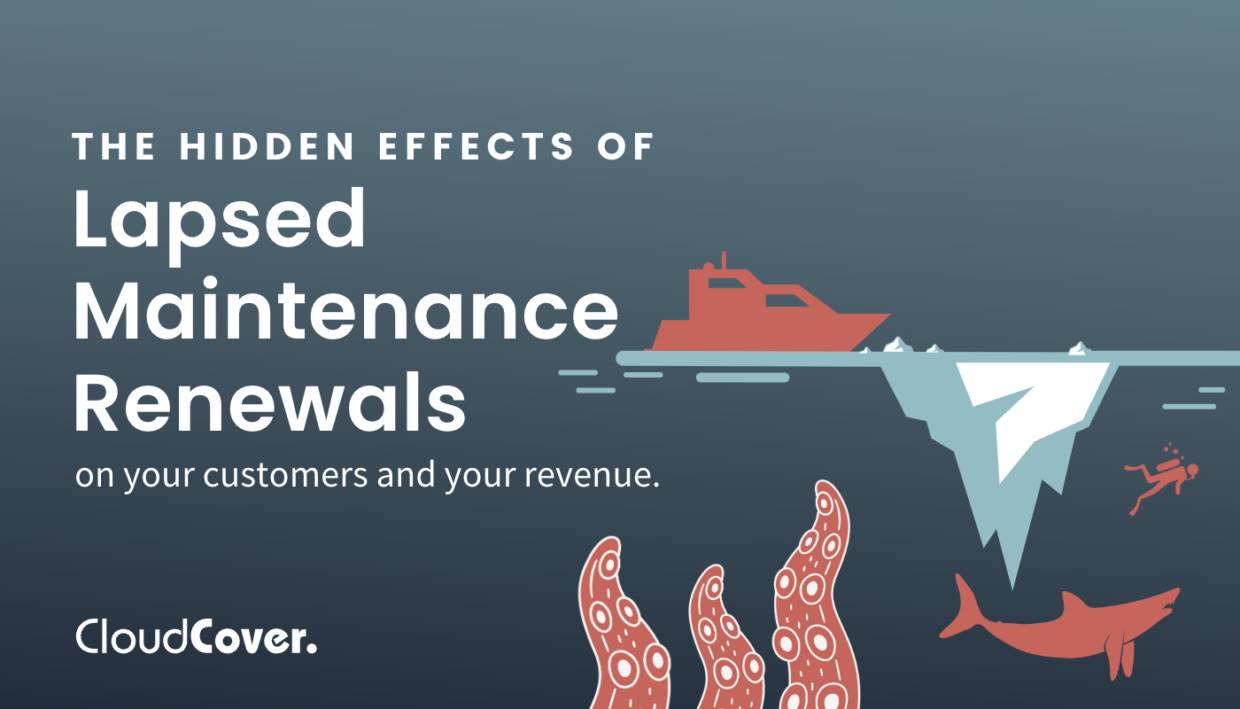
The Hidden Effects of Lapsed Maintenance Renewals on Your Customers and Your Revenue
- 5 Minute Read
- Channel Partners
There’s a saying that seem to fit when a sales team is faced with managing their smaller renewals, “is the juice worth the squeeze?” With so many variables that needs to be tracked, reviewed, and then followed up on, with smaller maintenance renewals, your sales team probably doesn’t think the effort needed, justifies the monetary return.
At face value, they’re correct. The problem is that every renewal — no matter what size — has a large amount of data that comes with it. It’s baggage that is weighing down your sales teams and perhaps more urgently, your revenue. Maybe you’ve grown to think that allowing those small renewals to lapse is “just the cost of business.”
While some customer churn is always going to happen, it’s worth reconsidering how much business you’re losing that you don’t have to be. Ignoring small things for too long usually means they just grow into bigger problems later. A lapsed renewal could be endemic of a larger problem brewing within your business that needs to be addressed.
On this post:
New Customers Are Expensive
What many businesses fail to realize is that the cost of a lapsed maintenance renewal goes much deeper and effects much more than just the single renewal lost.
Let’s pause here and really think about just how much effort needs to go into generating new business. According to analysts, it costs five times as much to attract a new customer as it does to keep an existing one. Not only do new customers cost more to earn but the return often isn’t as good as keeping and growing the customers you already have.
According to the XM Institute, loyal customers are five times as likely to repurchase, five times as likely to forgive, four times as likely to refer and seven times as likely to try a new offering. Additionally, increasing customer retention by 5% can increase profits by between 25% to 95%.
The success of selling an offering to a new customer versus an existing one also tends to be much lower. On average most sales teams have a 5-20% success rate of selling to a new customer versus a much more successful 60-70% rate with an existing.
You Are Losing More Customers Than You Realize
The data is clear. Retaining the customers you have fuels better revenue. But despite what the data is telling companies, according to the CallMiner Churn Index 2020, US companies are still losing $136.8 billion per year due to avoidable consumer switching.
Naturally losing some customers as your company grows can happen as some may turn into a poor market fit as your company evolves their services. That said, ideally with maintenance, you are getting a positive churn as customers invest more into the savings and services they get from using your company as a maintenance partner. Unfortunately, instead analysts are seeing that avoidable consumer switching – meaning the clients you don’t want to lose – are the ones that are being lost when it comes to maintenance renewals.
So why even with this data is your sales team losing out on an average of 30%+ of your existing maintenance renewals? More importantly, what is really happening each time a maintenance renewal lapses?
What is Really Happening Every Time Your Team Drops a Maintenance Renewal
Lapsed Renewals have several repercussions, including:
1. Forfeited Revenue
- The revenue of lapsed agreements is often forfeited. While a single agreement may not affect your bottom line, it’s likely your team is missing over 30% of these renewals which quickly becomes significant. For instance, an individual maintenance renewal worth $5,000 may not seem worth pursuing on its own. However, miss 10 of these “small” renewals a month and suddenly the company and the sales team are looking at a loss of hundreds of thousands of dollars a year.
2. Negative Operational Impacts
- As contracts lapse, important SLA’s are at risk of not being met. This creates a chain reaction, impacting your clients’ important company operations. In addition, the time and materials calls (T & M) needed to rectify missed SLA’s are expensive, adding another avoidable cost for your company and your clients’ companies.
3. Avoidable OEM Headaches
- Often as maintenance contracts lapse, recertifications are another consequence that need to be managed. Unfortunately, they are not as easily fixed, often requiring time-consuming and expensive interactions with OEM’s to rectify for the customer.
4. Customer Experience Impact
- One of the most damaging things to happen is that when a renewal lapses, it’s often the customer, not the vendor, that first sounds the alarm. This makes for a lopsided relationship and what can feel, to your customers, like an uneven partnership. Overall, when a renewal lapses customer experience is negatively impacted which is never a good thing. It reflects poorly on your organization if your customers become entangled in the work to amend renewals.
It’s also important to remember that ultimately as your customer contacts move and grow into other companies, your reputation moves with them. A negative customer experience today with one company can mean a lost revenue opportunity with a completely different company tomorrow.
It makes sense that small maintenance renewals aren’t a top priority for sales. If a company is still tracking customer data using a manual spreadsheet or as a secondary part of their CRM, the work involved to stay on top of every renewal is a lot of effort for very little commission and subject to multiple opportunities for human error and bad data.
Unfortunately, the effects on a single renewal lapsing go much deeper and take a good deal of time to resolve. By the time everything is said and done, rectifying a small maintenance renewal has probably already had big repercussions on your customers’ experiences, costs to your company, and your overall brand’s reputation. Luckily there are some steps a company can take to right-size their maintenance renewals.
ACCESS THE INFOGRAPHIC SUMMARY OF THIS BLOG
The Right Tech Can Increase Customer Retention Rates
So how do you protect your company from suffering the damage missed renewals can cause?
It’s MUCH easier to retain revenue than to be constantly acquiring new customers. While you could spend a lot of time reviewing your sales processes and customer journeys one of the quickest ways to scale is through simplification and automation of your processes.
Tired of Excel sheets, many VARs, MSP’s and even TPM’s are scrambling to create their own software to help them manage the warranty, contract, and other maintenance information associated with their clients. This makes sense but many maintenance contract management platforms are not comprehensive enough to solve the overall lack of visibility on customer maintenance information that plagues most companies and sales teams.
Often their dashboard is tied only to their maintenance services, not an overall view on maintenance contracts. Their “solution” won’t let you integrate ALL your TPM, OEM, and self-supported contract information in one place. This means your records are spread across multiple maintenance contract management (MCM) solutions, leaving you with yet another tool to be managed around in your tech stack.
A true MCM platform should offer a number of clear benefits, most notably the ability to view all of your contracts (and their associated components) in an easy-to-understand dashboard. It should also offer an open API so that integration is made easier for everyone.
Create a Self-Serve Offering for Your End Users
Many VARs and MSPs are also missing out on a larger opportunity that creating a single dashboard of their maintenance information can offer: how to use this same info to enhance their value with customers by building end users their own platform to manage their assets, tickets, and SLA’s. According to CallMiner, 44.7% of consumers would be more loyal with an effective self-service facility for simple tasks.
CloudCover offers a sister platform for our Channel Partners that they can brand and offer to their end users. We built it because we understood how important creating a solution that our Channel Partner clients can offer their end users could be to a company, looking to stand out from their competitors.
When you’re able to trust and work from the same data as your customers (or a “Single Source of Truth” as it’s sometimes known in the industry), your ability to recognize and add value to your customers’ maintenance becomes much easier for your sales and operations teams. Now they have a much better view on what to offer and how to scale those offerings within your existing client base. They can use the data to tailor better solutions to fit their clients’ needs.
And, as we learned earlier, existing clients are much easier to upsell on additional services, meaning an investment in them is a positive ROI for your company. It’s even easier to make a sale if you both have the same data readily available, backing up why a new solution makes sense for your client’s company.
Next Steps
Now that you understand the larger effects a lapsed maintenance renewal causes, it’s worth evaluating an automation platform. Ideally you should look for one your entire team and your end users can use to automate and manage their maintenance data.
Many of our customers came to us because they were looking for a way to get all of their contract maintenance data in one place. Our platform provides them with a simple intelligent dashboard view, regardless of the manufacturer, location, or type of equipment.
At the same time, they recognized that offering a comprehensive solution to their own customers extended their value and helped them add maintenance management as part of their managed services portfolio. We’d be happy to show give you a quick, no commitment demo of how the platform works.


